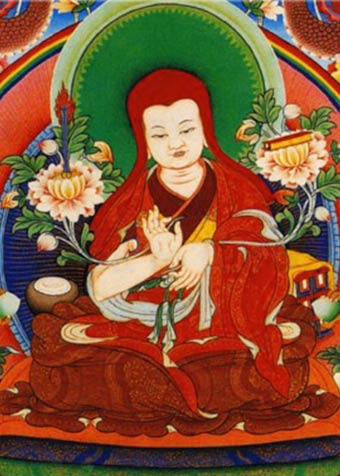果然巴·索南森格于藏历1429土鸡年诞生。尊者从1483年至1486年担任俄寺第6任法主。
因为其大智慧,果然巴广泛地被认证为萨迦三祖杰尊·扎巴坚赞的转世。
As a child Gorampa mastered reading effortlessly. When he attained the age of ten, Gorampa observed that all living beings who dwell in the world are afflicted by many various kinds of sufferings. Hence, he resolved to renounce the world and begged his parents’ permission to do so. He took monastic vows at age eight or ten and continued his early studies. It was recorded that Gorampa’s teachers were extremely impressed with his intellect.
十九岁时,果然巴就已经博通经纶,包括精通因明逻辑和般若密多的教义。接着他前往那烂陀寺,在那里值遇了伟大的萨迦派大师根钦荣敦(藏:遍知荣地导师),并从其处领受教法。
In his early twenties, Gorampa fell ill and was prevented from going on a tour of various monastic colleges as he had intended. Instead, in 1453, he went to live at Ngor Monastery–Ngor Ewaṃ Choden where he began to study tantra extensively under Ngorchen Kunga Zangpo (founder of the Ngor school). Gorampa was fully ordained when he was twenty-six. He received the full Lam Dre teachings twice as well as many other tantric instructions from Kunga Zangpo and the other teachers at Ngor.
In 1466 Gorampa founded Tanak Serling Monastery, where he stayed and taught for several years, although he also made occasional teaching trips to other monasteries. He wrote prolifically during that period and composed some of his most important works, receiving support from nobles associated with the Rinpung court in Tsang.
In 1473 Gorampa founded another monastery called Tanak Tubten Namgyel, where he established a curriculum that thoroughly addressed both exoteric and esoteric subjects. He taught there for most of the following decade.
1483年,果然巴被加冕成为俄支派第六任主持——俄支堪钦。在位期间他传授各种显密教法,特别是道果法,直到1486年退位。
从俄寺法座退位后,果然巴回到达那地方,传法之余,呕心沥血著书立说,直到生命终结。果然巴于1489年示寂。
Gorampa’s writings fill thirteen volumes. His most well-known and influential work was the Distinguishing of the View, a highly influential study of Tibetan Madhyamaka that describes in detail different interpretations of the Middle Way philosophy debated in Tibetan monasteries.

